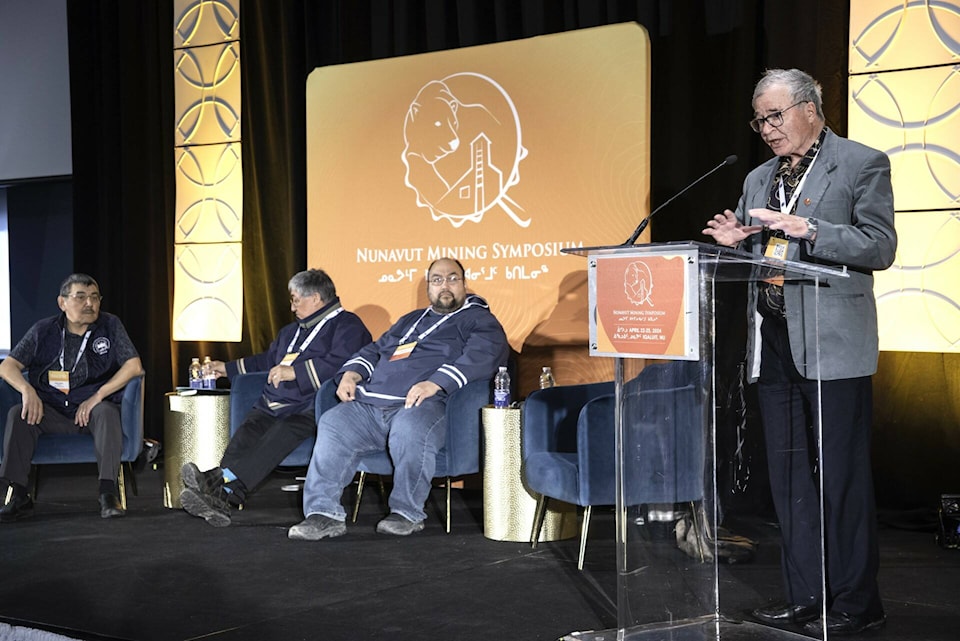The effects of devolution on labour relations and the economic impacts of resource development were the themes of this year’s regional Inuit association (RIA) panel at the 2024 Nunavut Mining Symposium.
This year, the panel comprised Olayuk Akesuk, president of the Qikiqtani Inuit Association (QIA); Gabe Karlik, chief operating officer of the Kivalliq Inuit Association (KIA); and Nunavut Tunngavik Incorporated (NTI) vice-president Paul Irngaut and Kevin Kablutsiak, NTI’s director of communications. Kitikmeot Inuit Association President Robert Greenley was unable to attend due to inclement weather.
According to Iqaluit Mayor Solomon Awa, the overarching “topic of concern” from all of the RIAs pertained to labour relations and Inuit hiring practices.
“That comes down to a lot of training,” said Awa. “The general idea is how the Inuit can benefit most… what I heard [from the panel] is [about] hiring Inuit and giving more employment opportunities to the local population, so the money stays in the community.”
Qikiqtani Inuit Association
“[QIA] has worked hard to ensure that Inuit in the Qikiqtani region benefit from responsible resource development, whether it be through direct employment, contracts awarded, and training opportunities that lead to employment,” Akesuk told Nunavut News.
The QIA is responsible for 13 Baffin communities and has had many projects on the go. Some examples discussed at the panel include:
-The Tuvaijuittuq Land Guardian program currently operating in five communities, which monitors the lands and waters and records harvesting and gathering samples.
-The Tulluriutiup Imanga (Lancaster Sound) Marine Protected Area, funded by the federal government, has resulted in five marine facilities in the High Arctic now under construction.
-The Q-Step training program has trained many Inuit at the training facility in Morrisburg, Ont., and recently was augmented by $25 million over five years to cover a variety of fields.
Panel moderator Dennis Patterson stated that “the QIA’s Qikiqtaaluk Corporation has 11 wholly-owned subsidiaries, most notably QC Fisheries, which is currently building its own new fishing vessel and developing Inuit expertise in fishing through the Nunavut Marine and Fisheries Training Consortium, which trains folks from all across Nunavut.
“Now that Nunavut has devolution,” Akesuk said, “we need to start looking at more ways we can support Inuit into getting into leadership positions that will directly or indirectly impact the resource development sector. In order to maximize economic benefits to Inuit from resource development projects, Inuit need to be at the design stage of the projects. Inuit need to understand what the proposed scope of the project will be and be provided the opportunity to respond to the proposed scope. One critical place this can happen when projects are proposed to take place on Inuit-owned lands is through the negotiation of Inuit Impact and Benefits Agreements.
“We want to see Inuit lead in as many aspects as possible, and we all need to work together to make this a reality. The more Inuit we train now in different professions, the more they will be ready to maximize benefits for themselves and for Inuit in their communities. We are committed to ensuring QIA advocates for responsible resource development that will help diversify the economy in Nunavut,” concluded Akesuk.
Nunavut Tunngavik Incorporated
“Resource development companies operating in Nunavut must formulate and faithfully execute comprehensive plans to train, educate, employ, and retain Inuit workers,” said Kablutsiak. “It is also just as important that these companies provide meaningful opportunities for Inuit-owned small businesses in Nunavut to carry out contract work. It has always been our view that any corporate undertaking in Nunavut should benefit our people.”
NTI is responsible for funding the operations of the RIAs from interest earned through the Nunavut Trust. Some initiatives have included monthly supplementary funding for Elders and a commitment of $2 million towards Inuit television programming.
According to Patterson, “NTI has a major role in delivering housing for the Nunavut 3000 strategy, and its Makigiaqta program has funded many programs, including youth camps, a nursing program and science projects for youth. NTI will be holding a strategic planning session to review its Revenue Trust Formula, for which $180 million has been set aside.”
Kivalliq Inuit Association
“The biggest thing from our perspective is jobs and training, and trying to balance this with wildlife and exploration,” said Karlik. “We’re the only region I know of that stops all operations and traffic during caribou migration season, because they go through the [mining area].”
He said it’s 10 to 14 days on average each year that mining operations are shut down so caribou can cross. Monitors with the Kivalliq Inuit Association and the hunters and trappers organizations are employed, and the Government of Nunavut is also a partner.
“It’s finding that balance,” he said. “We’re trying to balance everything and show a way to do both exploration and preservation of wildlife.”
